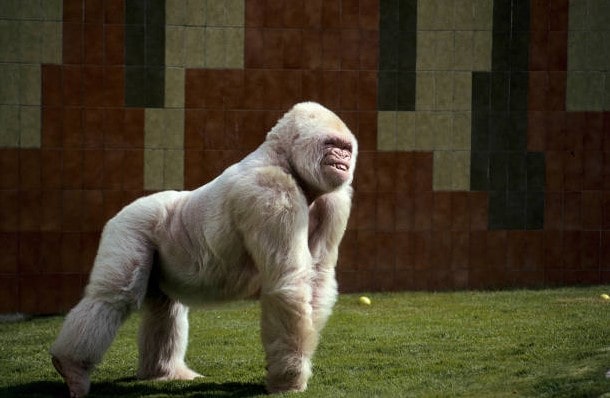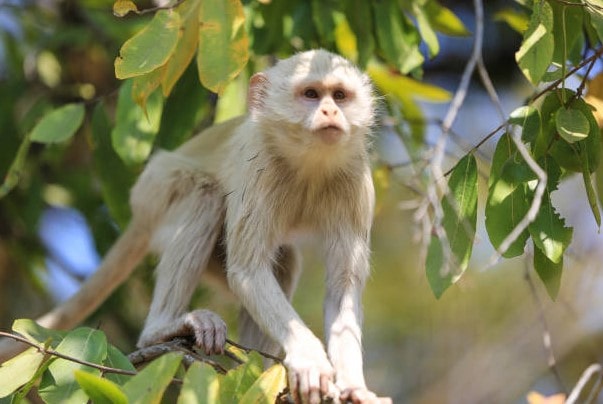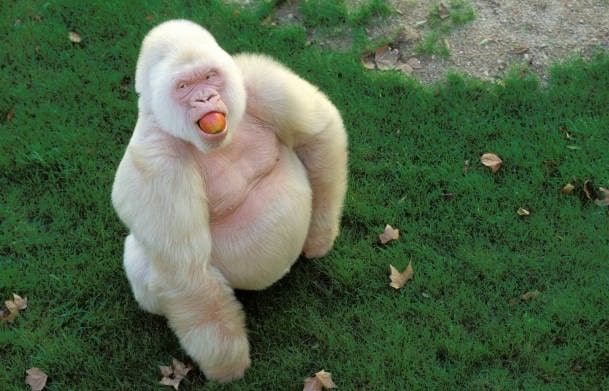Most animals are affected by albinism, a genetic abnormality. Associated with animals, people experience this issue more frequently. Some individuals should be aware of the distinctions between the illnesses since they mistake albinism for Down syndrome and monkeys. Compared to other conditions, albinism monkeys are more prevalent. People do not often encounter albinism monkeys because they are extremely uncommon. This is a result of the fact that albinism monkeys inhabit remote locations. They are seen in confinement. This page will go about albino monkey food, lifestyle, performance, and many other appearances.
Table of Contents
Albino Monkey Appearance

Born without any pigment in their skin, hair, or eyes, albino monkys are a rare and adorable variety of monkeys. As a result, they frequently have pale complexion and bulging eyes. The combination of these features gives this monkey a ghostly appearance, red eyes, white hair, and porcelain-white skin. Because they are rare in the world, albinism monkeys are extremely uncommon. Snowflake, the most well-known Albinism monkey, was housed in a zoo in Barcelona, Spain. Snow was a favourite sight for visitors and a symbol of hope and stability.
Albino Monkey Habitat
Albino monkys, so named because of their peculiar lack of pigmentation, inhabit a range of habitats worldwide. These critically endangered primates inhabit tropical rainforests, deep forests, and mountains. The diverse plants that are always adorning their surrounds might provide them with food and shelter. Albinism monkeys are incredibly active in tree trunks and have ground adaptations based on their surroundings. Protection measures are necessary to preserve this unique ecosystem’s environment because human encroachment and desertification pose a threat to it. It is essential to comprehend the subtleties of the albino monky system if we are to preserve these fascinating, yet sadly endangered, creatures.
Hairless Albino Monkey
In the realm of primates, hairless albino monkys are a fascinating mystery because of their unusual traits that defy assumptions. These individuals lack fur, in contrast to other common monkey species, due to genetic abnormalities that change the pigmentation and development of hair. Found in many tropical and subtropical regions, this amazing adaption depends on specialised skin to regulate body temperature. Its lack of fur gives it away as an albino, with its pale skin and bright red eyes. Conservation efforts are essential because of the difficulties these rare monkeys encounter in the wild, which also emphasises the need for more research and habitat preservation.
Albino Monkey Lifespan
With a lifespan of 15–25 years in the wild, this particular kind of monkey is well-known for its charming demeanour and distinct facial features. Their lifestyle, diet, and habits all have a significant impact on their overall health. Some may outgrow the health restrictions of their wild counterparts while in captivity, where they can get specialised medical attention. Their complex social systems and wide range of adaptations enable their overall survival and well-being. The key to effectively protecting ringtail monkeys in both their natural environments and while they are imprisoned is understanding the essential components of their life cycle.
Skinny
The lean albinism monkey is a rare and enigmatic creature that can be found among the luxuriant shadows of some tropical places. It has captivated the attention of both wildlife enthusiasts and researchers. This primate can be identified by its unique shiny coat and slim build in its natural environment. Their condition known as albinism, or lack of pigmentation, gives their existence a fascinating dimension. Scientists monitor hereditary and environmental impacts closely in an effort to learn more about behavioural issues and lifestyle issues. The idea of the lean albinism monkey emphasises the value of protecting various and unusual species in our dynamic ecosystem and advances knowledge of nature’s fragile balance.
Albino Monkey Baby

Due to a genetic defect that alters pigmentation, the albino monky newborn is a unique and fascinating creature that attracts attention with its dazzling white fur and pinkish complexion. This unusual primate, which may be seen in the wild, serves as a symbol of the value of conservation efforts and the beauty of biodiversity. Due to their lack of camouflage, albino animals suffer a number of difficulties, including greater susceptibility to sunlight and predators. Not only does their unique look captivate scientists, but it also emphasises how important it is to preserve their natural habitats for coming generations.
Albino Monkey With Glasses
The albino monkey with glasses is an intriguing sight, combining rarity and whimsy. This unique primate, characterized by its striking white fur and pink eyes, wears glasses that accentuate its curious expression. While the glasses may be a playful addition, they symbolize intelligence and adaptability. Such a creature captures the imagination, drawing attention to both the beauty of genetic diversity and the importance of wildlife conservation, reminding us of the fragile balance in nature.
People also ask
Q. Is an Albino Monkey rare?
Yes, albino monkys are rare due to genetic mutations.
Q. Do albino monkeys still exist?
Yes, albino monkys still exist, though they are uncommon.
Q. What is an Albino Monkey’s diet?
An albino monky’s diet primarily consists of fruits, leaves, seeds, and insects.
Q. Is Albino Monkey better than turtle?
Albino monkys and turtles have different strengths; comparisons depend on context.
